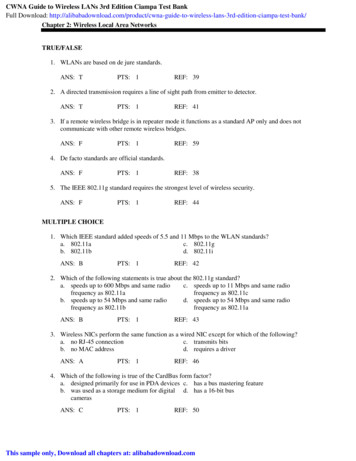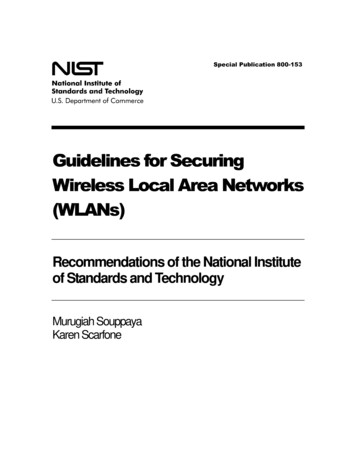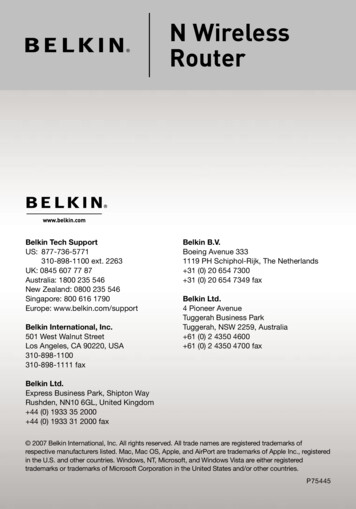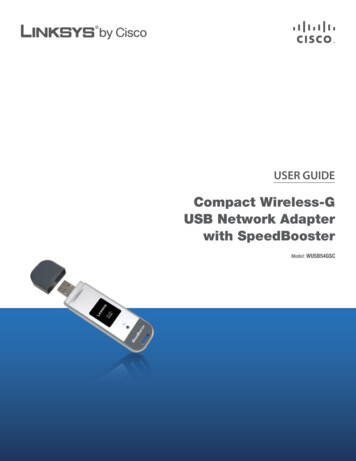
Transcription
CWNA Guide to Wireless LANs 3rd Edition Ciampa Test BankFull Download: ireless-lans-3rd-edition-ciampa-test-bank/Chapter 2: Wireless Local Area NetworksTRUE/FALSE1. WLANs are based on de jure standards.ANS: TPTS: 1REF: 392. A directed transmission requires a line of sight path from emitter to detector.ANS: TPTS: 1REF: 413. If a remote wireless bridge is in repeater mode it functions as a standard AP only and does notcommunicate with other remote wireless bridges.ANS: FPTS: 1REF: 594. De facto standards are official standards.ANS: FPTS: 1REF: 385. The IEEE 802.11g standard requires the strongest level of wireless security.ANS: FPTS: 1REF: 44MULTIPLE CHOICE1. Which IEEE standard added speeds of 5.5 and 11 Mbps to the WLAN standards?a. 802.11ac. 802.11gb. 802.11bd. 802.11iANS: BPTS: 1REF: 422. Which of the following statements is true about the 802.11g standard?a. speeds up to 600 Mbps and same radioc. speeds up to 11 Mbps and same radiofrequency as 802.11afrequency as 802.11cb. speeds up to 54 Mbps and same radiod. speeds up to 54 Mbps and same radiofrequency as 802.11bfrequency as 802.11aANS: BPTS: 1REF: 433. Wireless NICs perform the same function as a wired NIC except for which of the following?a. no RJ-45 connectionc. transmits bitsb. no MAC addressd. requires a driverANS: APTS: 1REF: 464. Which of the following is true of the CardBus form factor?a. designed primarily for use in PDA devices c. has a bus mastering featureb. was used as a storage medium for digital d. has a 16-bit buscamerasANS: CPTS: 1REF: 50This sample only, Download all chapters at: alibabadownload.com
5. Windows Vista and Windows 7 use which software for configuring wireless NICs?a. Wireless Zero Configurationc. MS WNIC Configb. WLAN AutoConfigd. AutoNIC ConfigurationANS: BPTS: 1REF: 516. Which type of remote wireless bridge connection is used to connect multiple LAN segments, orbuildings together?a. segment-to-segmentc. point-to-pointb. multipoint-to-multipointd. point-to-multipointANS: DPTS: 1REF: 587. If a remote wireless bridge is set to , it can only transmit to another bridge in root mode.a. access point modec. nonroot modeb. root moded. repeater modeANS: CPTS: 1REF: 598. Which of the following typically resides between the wireless network and the wired network, servingas the entry point to the wired network while providing encryption and authentication services?a. residential WLAN gatewayc. enterprise encryption gatewayb. point-to-multipoint remote wireless bridge d. point-to-point authenticating bridgeANS: CPTS: 1REF: 599. What are the two components that make up the Windows 7 wireless Hosted Network function?a. Windows Connect Now, SoftAPc. Virtual WiFi, ICSb. Virtual Wifi, SoftAPd. ICS, WCNANS: BPTS: 1REF: 6110. Which of the following is connected inline to each end device and adds power to the line?a. midspan devicec. SoftAPb. power sourcing equipmentd. EEGANS: APTS: 1REF: 6311. If you are installing an access point on a ceiling, but find there are no electrical outlets nearby toprovide power to the AP, what technology should you deploy?a. WCNc. POEb. SoftAPd. Virtual WifiANS: CPTS: 1REF: 6112. Which of the following is a viable option for a large enterprise or campus wireless network?a. autonomous access pointc. fat access pointb. lightweight access pointd. Soft access pointANS: BPTS: 1REF: 5313. Which of the following provides the management and configuration functions for a thin access point?a. wireless LAN controllerc. PoE controllerb. fat access pointd. mesh access pointANS: APTS: 1REF: 53
14. Which of the following is NOT a major part of an autonomous access point?a. antennac. bridging softwareb. wired network interfaced. wireless switchANS: DPTS: 1REF: 5115. Which is NOT a limitation of infrared wireless systems?a. lack of mobilityc. slow transmission speedb. doesn’t work well indoorsd. limited rangeANS: BPTS: 1REF: 4216. Which of the following is true about infrared transmissions?a. diffused transmission relies on reflectedc. they are most reliable outdoorslightb. directed transmission has a wide-focused d. mobility is their greatest strengthbeamANS: APTS: 1REF: 41MULTIPLE RESPONSE1. Which of the following are advantages of having standards govern how a technology works? (Chooseall that apply.)a. interoperabilityc. proprietary equipmentb. high profits from lower competitiond. lower costsANS: A, DPTS: 1REF: 38-392. Which of the following are improvements of the 802.11n standard over previous 802.11 standards?(Choose all that apply.)a. data rates up to 1.2 Gbpsc. securityb. coverage aread. different frequencies reduce interferenceANS: B, C, DPTS: 1REF: 443. Which of the following are modes in which a remote wireless bridge can function? (Choose all thatapply.)a. switching modec. routing modeb. nonroot moded. repeater modeANS: B, DPTS: 1REF: 59-604. Which of the following are differences between a remote wireless bridge and an AP? (Choose all thatapply.)a. remote wireless bridges have increasedc. remote wireless bridges providespowerencryptionb. remote wireless bridges have a directional d. remote wireless bridges only connectantennadevices in close proximityANS: A, BCOMPLETIONPTS: 1REF: 57
1.ensure that devices from one vendor will function with those from othervendors.ANS: StandardsPTS: 1REF: 372. The IEEE standard specified that wireless transmissions could occur viainfrared light or radio waves.ANS: 802.11PTS: 1REF: 403. Remote wireless can connect sites such as satellite offices, remote campussettings, or temporary office locations when the sites are separated by obstacles such as bodies ofwater, freeways, or railroads that make using a wired connection impractical or very expensive.ANS: bridgesPTS: 1REF: 594. A(n) is a device that receives a signal from an emitter.ANS: detectorPTS: 1REF: 415. A access point does not have to be individually connected by a cable to thewired network but can communicate with other access points of the same type to reach the wiredconnection.ANS: meshPTS: 1REF: 54MATCHINGMatch each term with the correct statement below.a. directed transmissionf.b. emitterg.c. form factorh.d. nonroot modei.e. PoE injectorrepeater moderoot bridgewireless mesh networkwireless switch1. device that contains the management and configuration functions for alightweight access point2. term used to refer to a wireless bridge operating in root mode3. an infrared wireless transmission that requires that the emitter anddetector be directly aimed at one another4. a mode of a wireless bridge that allows the bridge to extend the distancebetween buildings5. a small and inexpensive device that can inject power into an Ethernet cable
6. mode of a wireless bridge in which the bridge can transmit only to awireless bridge that is in root mode7. a network of wireless mesh access points that communicate between themselves8. a term used to refer to the size and shape of a device9. a device that transmits a signal and is used in an IEEE 802.11 infrared :535841596358634840SHORT ANSWER1. List the three sources of standards.ANS:De facto standardsDe jure standardsConsortia-created standardsPTS: 1REF: 392. What are the two functions of an access point?ANS:First, the access point acts as the base station for the wireless network. Any device with a wireless NICtransmits its signal to an AP, which can then redirect the signal, if necessary, to other wireless devices.The second function of an AP is to act as a bridge between the wireless and wired networks.PTS: 1REF: 513. A remote wireless bridges support two types of connections. Describe them.ANS:Remote wireless bridges support two types of connections, point-to-point and point-to-multipoint. In apoint-to-point (PtP) configuration, two buildings are connected. In a point-to-multipoint (PtMP)configuration, multiple buildings are connected.PTS: 1REF: 574. List and describe three advantages of standards for wireless technology.ANS:Interoperability. Standards ensure that devices from one vendor will function with those from othervendors. Devices that are not based on standards often cannot interoperate with similar devices fromother vendors.
Competition. Standards serve to create competition. If a vendor creates a new device without regard tocurrent standards, then it automatically owns the specifications for the device; the vendor might eventake out a patent on the device. This makes it virtually impossible for another vendor to produce thesame device; thus, competition among multiple vendors selling the same device is impossible. Fromthe point of view of the consumer, standards are desirable because they encourage competition. Anyvendorcan create a device based on a recognized standard. In order to compete, vendors will add additionalfeatures to their products, thus increasing the overall value for users.Lower costs. Competition results in lower costs for both users and manufacturers. When severalvendors make similar products based on the same standards, they compete against each other on theprice, which in turn makes the product less expensive for users. Competition also results in lower costsfor manufacturers. Because standards have been established, manufacturers do not need to invest largeamounts of capital in research and development. This reduces start-up costs as well as the amount oftime required to bring a product to market. Also, manufacturing to standards encourages manufacturersto deploy mass-production techniques and economies of scale to keep production costs low, withsavings that in turn are passed on to users.Protection. Standards help protect the user’s investment in equipment. It is not uncommon for aproprietary vendor to phase out a product line, leaving a business that purchased the equipment withtwo choices: continue to use the now-obsolete system with escalating costs for supplies and technicalsupport, or discard the legacy system and buy a new system. Both choices are costly. Standards,however, can help create a migration path for equipment upgrades. Newer standards are generallybackward compatible or at least provide a means of migrating to equipment based on the newerstandards at a minimal cost.PTS: 1REF: 37-385. Describe the difference between directed transmission and diffused transmission with respect toinfrared transmissions.ANS:A directed transmission requires that the emitter and detector be directly aimed at one another in a lineof sight (LoS) path. A diffused transmission relies on reflected light. The emitters on diffusedtransmissions have a wide-focused beam instead of a narrow beam and are pointed at the room’sceiling, which serves as the reflection point.PTS: 1REF: 416. List the four modes in which a wireless bridge can function.ANS:Root modeNonroot modeRepeater modeAccess point modePTS: 1REF: 58-597. What is a gateway and what types of gateways do you find in wireless networks?ANS:A gateway is a network device that acts as an entrance to another network. There are twotypes of gateways in wireless networks, Enterprise Encryption Gateways and residentialWLAN gateways.
CWNA Guide to Wireless LANs 3rd Edition Ciampa Test BankFull Download: ireless-lans-3rd-edition-ciampa-test-bank/PTS: 1REF: 598. List and describe the two terms used for measuring wireless network speeds.ANS:Data rate. The data rate is the theoretical maximum rated speed of a network. For example, the datarate for IEEE 802.11b is 11 Mbps. However, the data rate is only theoretical. Due to a variety offactors, a network rarely achieves its stated data rate.Throughput. Throughput is the measure of how much actual data can be sent per unit of time across anetwork. Throughput is often used to measure the amount of data actually sent across a network in areal world setting. If two 802.11 devices are 30 feet (10 meters) apart, the throughput may only be 5.5Mbps.PTS: 1REF: 439. Describe the Microsoft Windows 7 feature referred to as the wireless Hosted Network.ANS:This feature has two parts: the virtualization of the physical wireless NIC into multiple virtual wirelessNICs (called Virtual WiFi) and a software-based wireless access point (SoftAP) that uses a designatedvirtual wireless NIC. The wireless Hosted Network allows users to extend the functionality of theirportable laptop computer. For example, a user could set up her computer to create a wireless networkso that other users can quickly share documents wirelessly between multiple computers. Anotherfunction allows a laptop’s network connection to be shared by other computers and devices. Forexample, a user could connect her computer to the Internet and then turn her computer into an AP thatshares the Internet connection with other wireless laptop devices, much like a hardware AP.PTS: 1REF: 60-6110. Describe a PoE injector.ANS:PoE injector is a small, inexpensive device that can inject power into an Ethernet cable. Theseinjectors can be endspan devices (such as a network switch enabled to provide power on each port) ora midspan device, which is connected inline to each end device and adds power to the line. Using PoEinjectors, a standard, non–PoE-enabled Ethernet switch can be used to supply the data while the PoEinjector provides the power.PTS: 1REF: 63This sample only, Download all chapters at: alibabadownload.com
2.term used t o refer to a wireless bridge operating in root mode 3.an infrared wireless transmission that requires that the emitter and detector be directly aimed at one another 4.a mode of a wireless bridge that allows the bridge to extend the distance between buildings 5.a small and inexpensive device that can inject power into an Ethernet cable











